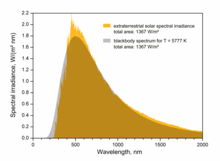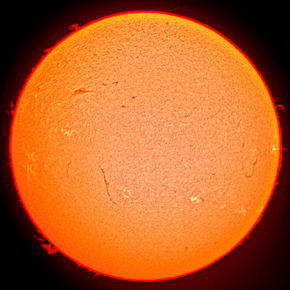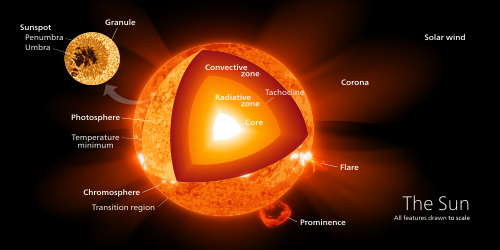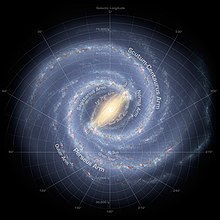Sun
This article is about the star. For other uses, see Sun (disambiguation).
The Sun (in Greek: Helios, in Latin: Sol[a]) is thestar at the center of the Solar System and is by far the most important source of energyfor life on Earth. It is a nearly perfect spherical ball of hot plasma,[13][14] with internal convective motion that generates amagnetic field via a dynamo process.[15] Its diameter is about 109 times that of Earth, and it has a mass about 330,000 times that of Earth, accounting for about 99.86% of the total mass of the Solar System.[16] About three quarters of the Sun's mass consists ofhydrogen; the rest is mostly helium, with much smaller quantities of heavier elements, including oxygen, carbon, neon and iron.[17]
The Sun is a G-type main-sequence star (G2V) based on spectral class and it is informally referred to as a yellow dwarf. It formed approximately 4.567 billion[b][18] years ago from the gravitational collapse of matter within a region of a large molecular cloud. Most of this matter gathered in the center, whereas the rest flattened into an orbiting disk that became the Solar System. The central mass became increasingly hot and dense, eventually initiating nuclear fusion inits core. It is thought that almost all starsform by this process.
The Sun is roughly middle aged and has not changed dramatically for four billion[b] years, and will remain fairly stable for another four billion years. However, after hydrogen fusion in its core has stopped, the Sun will undergo severe changes and become a red giant. It is calculated that the Sun will become sufficiently large to engulf the current orbits of Mercury, Venus, and possibly Earth.
The enormous effect of the Sun on the Earth has been recognized since prehistoric times, and the Sun has been regarded by some cultures as a deity. Earth's movement around the Sun is the basis of the solar calendar, which is the predominant calendar in use today.
Name and etymology
Characteristics
Sunlight
Composition
Structure
Core
Main article: Solar core
The core of the Sun extends from the center to about 20–25% of the solar radius.[63] It has a density of up to 150 g/cm3[64][65] (about 150 times the density of water) and a temperature of close to 15.7 million kelvin (K).[65] By contrast, the Sun's surface temperature is approximately 5,800 K. Recent analysis ofSOHO mission data favors a faster rotation rate in the core than in the rest of the radiative zone.[63] Through most of the Sun's life, energy is produced by nuclear fusion in the core region through a series of steps called the p–p (proton–proton) chain; this process converts hydrogen into helium.[66]Only 0.8% of the energy generated in the Sun comes from the CNO cycle, though this proportion is expected to increase as the Sun gets older.[67]
The core is the only region in the Sun that produces an appreciable amount of thermal energy through fusion; 99% of the power is generated within 24% of the Sun's radius, and by 30% of the radius, fusion has stopped nearly entirely. The rest of the Sun is heated by this energy that is transferred outwards through many successive layers to the solar photosphere before it escapes into space as sunlight or the kinetic energy of particles.[47][68]
The proton–proton chain occurs around9.2×1037 times each second in the core, converting about 3.7×1038 protons into alpha particles (helium nuclei) every second (out of a total of ~8.9×1056 free protons in the Sun), or about 6.2×1011 kg/s.[47] Fusing four freeprotons (hydrogen nuclei) into a single alpha particle (helium nuclei) releases around 0.7% of the fused mass as energy,[69] so the Sun releases energy at the mass–energy conversion rate of 4.26 million metric tons per second, for 384.6 yotta watts (3.846×1026 W),[1] or 9.192×1010 megatonsof TNT per second. Theoretical models of the Sun's interior indicate a power density of approximately 276.5 W/m3,[70] a value that more nearly approximates reptile metabolism than a thermonuclear bomb.[e]
The fusion rate in the core is in a self-correcting equilibrium: a slightly higher rate of fusion would cause the core to heat up more and expand slightly against the weight of the outer layers, reducing the fusion rate and correcting the perturbation; and a slightly lower rate would cause the core to cool and shrink slightly, increasing the fusion rate and again reverting it to its present level.[71][72]
Radiative zone
Main article: Radiative zone
From the core out to about 0.7 solar radii,thermal radiation is the primary means of energy transfer.[73] This zone is not regulated by thermal convection. The temperature drops from approximately 7 million to 2 million kelvin with increasing distance from the core.[65] This temperature gradient is less than the value of the adiabatic lapse rate and hence cannot drive convection.[65] Energy is transferred by radiation—ions of hydrogenand helium emit photons, which travel only a brief distance before being reabsorbed by other ions.[73] The density drops a hundredfold (from 20 g/cm3 to only 0.2 g/cm3) from 0.25 solar radii to the top of the radiative zone.[73]
Tachocline
Main article: Tachocline
The radiative zone and the convective zone are separated by a transition layer, thetachocline. This is a region where the sharp regime change between the uniform rotation of the radiative zone and the differential rotation of the convection zone results in a large shear—a condition where successive horizontal layers slide past one another.[74]The fluid motions found in the convection zone above, slowly disappear from the top of this layer to its bottom, matching the calm characteristics of the radiative zone on the bottom. Presently, it is hypothesized (seeSolar dynamo) that a magnetic dynamo within this layer generates the Sun's magnetic field.[65]
Convective zone
Main article: Convection zone
In the Sun's outer layer, from its surface to approximately 200,000 km below (70% of the solar radius from the center), the temperature is lower than in the radiative zone and heavier atoms are not fully ionized. As a result, radiative heat transport is less effective. The density of the plasma is low enough to allow convective currents to develop. Material heated at the tachocline picks up heat and expands, thereby reducing its density and allowing it to rise. As a result, thermal convection develops as thermal cells carry the majority of the heat outward to the Sun's photosphere. Once the material diffusively and radiatively cools just beneath the photospheric surface, its density increases, and it sinks to the base of the convection zone, where it picks up more heat from the top of the radiative zone and the convective cycle continues. At the photosphere, the temperature has dropped to 5,700 K and the density to only 0.2 g/m3 (about 1/6,000th the density of air at sea level).[65]
The thermal columns in the convection zone form an imprint on the surface of the Sun as the solar granulation and supergranulation. The turbulent convection of this outer part of the solar interior sustains "small-scale" dynamo action over the near-surface volume of the Sun.[65] The Sun's thermal columns areBénard cells and take the shape of hexagonal prisms.[75]
Photosphere

The effective temperature, or black body temperature, of the Sun (5,777 K) is the temperature a black body of the same size must have to yield the same total emissive power.
Main article: Photosphere
The visible surface of the Sun, the photosphere, is the layer below which the Sun becomes opaque to visible light.[76] Above the photosphere visible sunlight is free to propagate into space, and its energy escapes the Sun entirely. The change in opacity is due to the decreasing amount of H− ions, which absorb visible light easily.[76] Conversely, the visible light we see is produced as electrons react with hydrogen atoms to produce H−ions.[77][78] The photosphere is tens to hundreds of kilometers thick, being slightly less opaque than air on Earth. Because the upper part of the photosphere is cooler than the lower part, an image of the Sun appears brighter in the center than on the edge or limbof the solar disk, in a phenomenon known aslimb darkening.[76] The spectrum of sunlight has approximately the spectrum of a black-body radiating at about 6,000 K, interspersed with atomic absorption lines from the tenuous layers above the photosphere. The photosphere has a particle density of ~1023 m−3 (about 0.37% of the particle number per volume of Earth's atmosphere at sea level). The photosphere is not fully ionized—the extent of ionization is about 3%, leaving almost all of the hydrogen in atomic form.[79]
During early studies of the optical spectrumof the photosphere, some absorption lines were found that did not correspond to anychemical elements then known on Earth. In 1868, Norman Lockyer hypothesized that these absorption lines were caused by a new element that he dubbed helium, after the Greek Sun god Helios. Twenty-five years later, helium was isolated on Earth.[80]
Atmosphere
See also: Corona and Coronal loop

During a total solar eclipse, the solarcorona can be seen with the naked eye, during the brief period of totality.
During a total solar eclipse, when the disk of the Sun is covered by that of the Moon, the Sun's surrounding atmosphere can be seen. It is composed of three distinct parts: thechromosphere, the transition region, and thecorona, that together form the heliosphere.[76]
The coolest layer of the Sun is a temperature minimum region about 500 km above the photosphere, with a temperature of about4,100 K.[76] This part of the Sun is cool enough to allow the existence of simple molecules such as carbon monoxide and water, which can be detected via their absorption spectra.[81]
The chromosphere, transition region, and corona are much hotter than the surface of the Sun.[76] The reason is not well understood, but evidence suggests that Alfvén waves may have enough energy to heat the corona.[82]
Above the temperature minimum layer is a layer about 2,000 km thick, dominated by a spectrum of emission and absorption lines.[76] It is called the chromosphere from the Greek root chroma, meaning color, because the chromosphere is visible as a colored flash at the beginning and end of total solar eclipses.[73] The temperature in the chromosphere increases gradually with altitude, ranging up to around 20,000 K near the top.[76] In the upper part of the chromosphere helium becomes partiallyionized.[83]

Taken by Hinode's Solar Optical Telescope on 12 January 2007, this image of the Sun reveals the filamentary nature of the plasma connecting regions of different magnetic polarity.
Above the chromosphere, in a thin (about 200 km) transition region, the temperature rises rapidly from around 20,000 K in the upper chromosphere to coronal temperatures closer to 1,000,000 K.[84] The temperature increase is facilitated by the full ionization of helium in the transition region, which significantly reduces radiative cooling of the plasma.[83] The transition region does not occur at a well-defined altitude. Rather, it forms a kind of nimbus around chromospheric features such as spicules andfilaments, and is in constant, chaotic motion.[73] The transition region is not easily visible from Earth's surface, but is readily observable from space by instruments sensitive to the extreme ultraviolet portion of the spectrum.[85]
The corona is the next layer of the Sun. The low corona, near the surface of the Sun, has a particle density around 1015 m−3 to 1016 m−3.[83][f] The average temperature of the corona and solar wind is about 1,000,000–2,000,000 K; however, in the hottest regions it is 8,000,000–20,000,000 K.[84] Although no complete theory yet exists to account for the temperature of the corona, at least some of its heat is known to be from magnetic reconnection.[84][86] The corona is the extended atmosphere of the Sun, which has a volume much larger than the volume enclosed by the Sun's photosphere. A flow of plasma outward from the Sun into interplanetary space is the solar wind.[86]
The heliosphere, the tenuous outermost atmosphere of the Sun, is filled with the solar wind plasma. This outermost layer of the Sun is defined to begin at the distance where the flow of the solar wind becomes superalfvénic—that is, where the flow becomes faster than the speed of Alfvén waves,[87] at approximately 20 solar radii (0.1 AU). Turbulence and dynamic forces in the heliosphere cannot affect the shape of the solar corona within, because the information can only travel at the speed of Alfvén waves. The solar wind travels outward continuously through the heliosphere,[88][89] forming the solar magnetic field into a spiral shape,[86]until it impacts the heliopause more than 50AU from the Sun. In December 2004, theVoyager 1 probe passed through a shock front that is thought to be part of the heliopause. Both of the Voyager probes have recorded higher levels of energetic particles as they approach the boundary.[90]
Photons and neutrinos
High-energy gamma-ray photons initially released with fusion reactions in the core are almost immediately absorbed by the solar plasma of the radiative zone, usually after traveling only a few millimeters. Re-emission happens in a random direction and usually at a slightly lower energy. With this sequence of emissions and absorptions, it takes a long time for radiation to reach the Sun's surface. Estimates of the photon travel time range between 10,000 and 170,000 years.[91] In contrast, it takes only 2.3 seconds for theneutrinos, which account for about 2% of the total energy production of the Sun, to reach the surface. Because energy transport in the Sun is a process that involves photons in thermodynamic equilibrium with matter, the time scale of energy transport in the Sun is longer, on the order of 30,000,000 years. This is the time it would take the Sun to return to a stable state, if the rate of energy generation in its core were suddenly changed.[92]
Neutrinos are also released by the fusion reactions in the core, but, unlike photons, they rarely interact with matter, so almost all are able to escape the Sun immediately. For many years measurements of the number of neutrinos produced in the Sun were lower than theories predicted by a factor of 3. This discrepancy was resolved in 2001 through the discovery of the effects of neutrino oscillation: the Sun emits the number of neutrinos predicted by the theory, but neutrino detectors were missing 2⁄3 of them because the neutrinos had changed flavor by the time they were detected.[93]
The Sun, as seen from low Earth orbit overlooking the International Space Station. This sunlight is not filtered by the lower atmosphere, which blocks much of the solar spectrum During certain atmospheric conditions, the Sun becomes clearly visible to the naked eye, and can be observed without stress to the eyes. Click on this photo to see the full cycle of a sunset, as observed from the high plains of the Mojave Desert.Orbit in Milky Way
During certain atmospheric conditions, the Sun becomes clearly visible to the naked eye, and can be observed without stress to the eyes. Click on this photo to see the full cycle of a sunset, as observed from the high plains of the Mojave Desert.Orbit in Milky Way
The Sun lies close to the inner rim of theMilky Way's Orion Arm, in the Local Interstellar Cloud or the Gould Belt, at a distance of 7.5–8.5 kpc (25,000–28,000 light-years) from the Galactic Center.[124][125][126][127][128][129] The Sun is contained within the Local Bubble, a space of rarefied hot gas, possibly produced by the supernova remnantGeminga.[130] The distance between the local arm and the next arm out, the Perseus Arm, is about 6,500 light-years.[131] The Sun, and thus the Solar System, is found in what scientists call the galactic habitable zone. The Apex of the Sun's Way, or the solar apex, is the direction that the Sun travels through space in the Milky Way, relative to other nearby stars. The general direction of the Sun's galactic motion is towards the star Vega in the constellation of Lyra at an angle of roughly 60 sky degrees to the direction of theGalactic Center. Of the 50 nearest stellar systems within 17 light-years from Earth (the closest being the red dwarf Proxima Centauriat approximately 4.2 light-years), the Sun ranks fourth in mass.[132]
The Sun's orbit around the Milky Way is expected to be roughly elliptical with the addition of perturbations due to the galactic spiral arms and non-uniform mass distributions. In addition the Sun oscillates up and down relative to the galactic plane approximately 2.7 times per orbit.[133] It has been argued that the Sun's passage through the higher density spiral arms often coincides with mass extinctions on Earth, perhaps due to increased impact events.[134] It takes the Solar System about 225–250 million years to complete one orbit through the Milky Way (agalactic year),[135] so it is thought to have completed 20–25 orbits during the lifetime of the Sun. The orbital speed of the Solar System about the center of the Milky Way is approximately 251 km/s (156 mi/s).[136] At this speed, it t

The brightness of the Sun can cause pain from looking at it with the naked eye; however, doing so for brief periods is not hazardous for normal non-dilated eyes.[177][178] Looking directly at the Sun causes phosphene visual artifacts and temporary partial blindness. It also delivers about 4 milliwatts of sunlight to the retina, slightly heating it and potentially causing damage in eyes that cannot respond properly to the brightness.[179][180] UV exposure gradually yellows the lens of the eye over a period of years, and is thought to contribute to the formation of cataracts, but this depends on general exposure to solar UV, and not whether one looks directly at the Sun.[181]Long-duration viewing of the direct Sun with the naked eye can begin to cause UV-induced, sunburn-like lesions on the retina after about 100 seconds, particularly under conditions where the UV light from the Sun is intense and well focused;[182][183] conditions are worsened by young eyes or new lens implants (which admit more UV than aging natural eyes), Sun angles near the zenith, and observing locations at high altitude.
Viewing the Sun through light-concentratingoptics such as binoculars may result in permanent damage to the retina without an appropriate filter that blocks UV and substantially dims the sunlight. When using an attenuating filter to view the Sun, the viewer is cautioned to use a filter specifically designed for that use. Some improvised filters that pass UV or IR rays, can actually harm the eye at high brightness levels.[184]Herschel wedges, also called Solar Diagonals, are effective and inexpensive for small telescopes. The sunlight that is destined for the eyepiece is reflected from an unsilvered surface of a piece of glass. Only a very small fraction of the incident light is reflected. The rest passes through the glass and leaves the instrument. If the glass breaks because of the heat, no light at all is reflected, making the device fail-safe. Simple filters made of darkened glass allow the full intensity of sunlight to pass through if they break, endangering the observer's eyesight. Unfiltered binoculars can deliver hundreds of times as much energy as using the naked eye, possibly causing immediate damage. It is claimed that even brief glances at the midday Sun through an unfiltered telescope can cause permanent damage.[185]
Partial solar eclipses are hazardous to view because the eye's pupil is not adapted to the unusually high visual contrast: the pupil dilates according to the total amount of light in the field of view, not by the brightest object in the field. During partial eclipses most sunlight is blocked by the Moon passing in front of the Sun, but the uncovered parts of the photosphere have the same surface brightness as during a normal day. In the overall gloom, the pupil expands from ~2 mm to ~6 mm, and each retinal cell exposed to the solar image receives up to ten times more light than it would looking at the non-eclipsed Sun. This can damage or kill those cells, resulting in small permanent blind spots for the viewer.[186] The hazard is insidious for inexperienced observers and for children, because there is no perception of pain: it is not immediately obvious that one's vision is being destroyed.
During sunrise and sunset, sunlight is attenuated because of Rayleigh scatteringand Mie scattering from a particularly long passage through Earth's atmosphere,[187] and the Sun is sometimes faint enough to be viewed comfortably with the naked eye or safely with optics (provided there is no risk of bright sunlight suddenly appearing through a break between clouds). Hazy conditions, atmospheric dust, and high humidity contribute to this atmospheric attenuation.[188]
An optical phenomenon, known as a green flash, can sometimes be seen shortly after sunset or before sunrise. The flash is caused by light from the Sun just below the horizon being bent (usually through a temperature inversion) towards the observer. Light of shorter wavelengths (violet, blue, green) is bent more than that of longer wavelengths (yellow, orange, red) but the violet and blue light is scattered more, leaving light that is perceived as green.[189]
Ultraviolet light from the Sun has antisepticproperties and can be used to sanitize tools and water. It also causes sunburn, and has other medical effects such as the production of vitamin D. Ultraviolet light is strongly attenuated by Earth's ozone layer, so that the amount of UV varies greatly with latitude and has been partially responsible for many biological adaptations, including variations inhuman skin color in different regions of the globe.[190






No comments:
Post a Comment